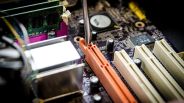The inner moons of Saturn are some of the oddest-shaped places in the solar system. A new study reveals how they likely received their special shapes.
Images Of Saturn's Inner Moons
Previously, scientists did not have a formal explanation about why Saturn's inner moons have peculiar shapes. A new study has revealed that collisions and mergers between the moonlets likely formed the shapes.
The study was published on May 21 in Nature Astronomy.
Images of the moons were first captured by the Cassini spacecraft in April 2017. Although there were some theories about the formation of the moons, they did not take into account the tidal forces of Saturn.
"The Cassini spacecraft revealed the spectacular, highly irregular shapes of the small inner moons of Saturn, ranging from the unique 'ravioli-like' forms of Pan and Atlas to the highly elongated structure of Prometheus," the researchers wrote in the study.
Saturn is about 95 times larger than the Earth, and the inner moons travel at a closer distance than the Earth and its moon. The pull from Saturn played a big tole in the formation of the inner moons.
Running Computer Simulations To Find The Answer
To determine the true cause of the shape of the inner moons, researchers developed computer simulations of each moon's orbit. Within the simulations, researchers virtually smacked the moons together until they discovered the real culprit.
The researchers tested out different angles and speeds, and how each scenario could result in a different odd shape.
Findings From The Computer Simulations
Light areas of the moons are where the impacts occurred, and dark areas are likely the original surfaces of each moon.
The researchers discovered that more flattened inner moons were likely caused by head-on mergers. Longer moons with smaller widths were possibly the result of an impact from the side. A few of the impacts might have caused moons to split apart.
"If the impact angle is bigger than 10 degrees, the resulting shapes are not stable anymore," said study co-author Adrien Lela.
It is estimated from the findings that 20 to 50 percent of the inner moons have an equatorial ridge or long shape. Other moons are in the shape of a potato.
"A significant fraction of such merging collisions take place either at the first encounter or after 1-2 hit-and-run events," the authors wrote. "In this respect, Saturn is almost a toy system to study these processes."
ⓒ 2025 TECHTIMES.com All rights reserved. Do not reproduce without permission.




